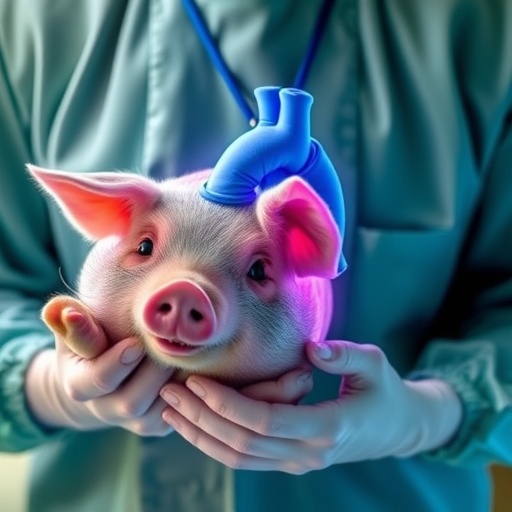
In the realm of organ transplantation, the notion of moving beyond human donors has emerged as a viable, albeit complex, consideration. Genetically modified porcine-to-human cardiac xenotransplantation is one avenue of this exploration that has garnered significant attention. The recent work of Kawamura et al. in 2025 sheds crucial light on this groundbreaking field, analyzing the current status and future prospects of this revolutionary medical approach.
Currently, organ shortages remain a pressing issue worldwide, leading to a substantial number of patients who die awaiting transplants. Advances in technologies and genetic engineering might offer solutions to alleviate this crisis, particularly by utilizing pigs, whose organs are anatomically and physiologically similar to those of humans. The application of genetically modified organisms, especially with respect to organ harvesting, could change the landscape of transplantation forever.
The genetic modification of pigs used in xenotransplantation is primarily aimed at reducing the risk of rejection once the organ has been transplanted into a human recipient. Pigs serve as ideal candidates due to their quick growth rates and the similarities in organ size and function. However, the challenge has been the activation of human immune responses against foreign tissues, which can lead to organ rejection. Kawamura and his team emphasize how advanced genetic modification techniques can circumvent these issues by eliminating certain human antigens that trigger immune reactions.
One of the major triumphs in this area of research has been the creation of genetically modified pig strains. These pigs have been engineered to express specific human-compatible genes while silencing those that lead to immune rejection. This fine-tuning of the genetic blueprint is at the heart of making porcine organs viable for transplantation in humans. In particular, the CRISPR-Cas9 gene-editing technology has revolutionized the ability to create these genetically modified organisms with precision and efficiency.
As researchers delve deeper, they also acknowledge the ethical considerations surrounding xenotransplantation. Concerns regarding animal welfare and the potential for zoonotic diseases—viruses that can jump from animals to humans—complicate the conversation. Kawamura et al. stress the importance of comprehensive risk assessments and strict regulatory frameworks to ensure that advancements do not come at an unacceptably high cost to public health or animal rights.
Additionally, the potential for socioeconomic disparities in access to genetically modified organs presents an issue that cannot be overlooked. If such innovations become available, there is a pressing need for policies that ensure equitable access for all patients, regardless of their socioeconomic status. Both researchers and policymakers will need to collaborate closely to address these concerns as the field develops.
Preclinical trials have illustrated the feasibility of porcine-to-human cardiac xenotransplantation, with several studies showcasing success in transplanting genetically modified hearts into non-human primates. These trials are instrumental in gauging physiological responses, organ function, and the adaptation of host immune systems. The positive outcomes from these studies pave the way for future human trials, heralding a new era in transplant medicine.
Despite the promise, challenges remain that must be surmounted before xenotransplantation enters mainstream medical practice. For example, the long-term effects of such transplants are still under scrutiny. Researchers like Kawamura and his colleagues highlight the necessity of long-term monitoring protocols for recipients to ensure that their bodies can adapt adequately without experiencing severe complications.
Moreover, there remains a question as to how public perception will shift in response to these developments. In an age where consumers are increasingly attuned to ethical sourcing and biogenetic technologies, transparent communication about the processes and the science behind xenotransplantation will be essential. This transparency will not only foster trust among the public but also perhaps even spark interest in participating as potential recipients in future trials.
As geneticists and medical professionals venture further into the unknown, the prospect of successfully implementing pig-derived organs into human medicine can potentially save countless lives. This innovative research signifies a paradigm shift, where the boundaries of what is medically possible are continuously being redefined. However, with every avenue of exploration, there lies a road filled with ethical dilemmas, scientific challenges, and societal implications that must be thoughtfully navigated.
In conclusion, although the journey of genetically modified porcine-to-human cardiac xenotransplantation is fraught with complexities, the work of Kawamura et al. serves as both a beacon of hope and a call to action. The myriad possibilities that lie ahead could not only reshape the face of transplantation but also offer profound improvements in quality of life for patients suffering from severe cardiac conditions.
As research accelerates and collaborations bolster findings in this exciting domain, the prospect of clinically viable porcine organ options becomes ever closer to reality. Continued investigation, coupled with an open dialogue about ethical practices, safety measures, and patient access, will frame the next chapters in the annals of medical science.
In summary, the future of organ transplantation could very well hinge on the successful incorporation of genetically engineered organs from pigs. The work of Kawamura and colleagues provides the groundwork for a significant transformation in how we perceive organ donation and transplantation, merging ethics, science, and patient care in an unprecedented way.
Subject of Research: Genetically modified porcine-to-human cardiac xenotransplantation
Article Title: Current status and prospects of genetically modified porcine-to-human cardiac xenotransplantation
Article References:
Kawamura, T., Saito, S., Taguchi, T. et al. Current status and prospects of genetically modified porcine-to-human cardiac xenotransplantation.
J Artif Organs 28, 348–353 (2025). https://doi.org/10.1007/s10047-025-01504-z
Image Credits: AI Generated
DOI: https://doi.org/10.1007/s10047-025-01504-z
Keywords: organ transplantation, xenotransplantation, genetic modification, CRISPR, porcine organs, heart transplant, immunology, ethics in medicine
Tags: advancements in xenotransplantationethical considerations in xenotransplantationfuture prospects of heart xenotransplantationgenetic engineering in organ transplantationimmunological challenges in organ transplantsinnovations in transplantation technologyKawamura et al. research findingsmedical breakthroughs in organ harvestingorgan donor shortages solutionspig-to-human heart transplantsporcine organ compatibility with humansreducing organ rejection in transplants




